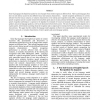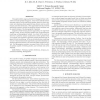757 search results - page 12 / 152 » Recognition Performance of a Structured Language Model |
LREC
2008
13 years 9 months ago
2008
Some big languages like English are spoken by a lot of people whose mother tongues are different from. Their second languages often have not only distinct accent but also differen...
ICASSP
2011
IEEE
12 years 11 months ago
2011
IEEE
In this work, we compare several known approaches for multilingual acoustic modeling for three languages, Dari, Farsi and Pashto, which are of recent geo-political interest. We de...
ICASSP
2011
IEEE
12 years 11 months ago
2011
IEEE
This paper presents ongoing research leveraging forensic methods for automatic speaker recognition. Some of the methods forensic scientists employ include identifying speaker dist...
INTERSPEECH
2010
13 years 2 months ago
2010
Neural network language models (NNLM) have become an increasingly popular choice for large vocabulary continuous speech recognition (LVCSR) tasks, due to their inherent generalisa...
ECCV
2010
Springer
13 years 11 months ago
2010
Springer
Abstract. Much recent research in human activity recognition has focused on the problem of recognizing simple repetitive (walking, running, waving) and punctual actions (sitting up...


